“She was, arguably, the most famous actress of the 19th century. Not the most beautiful or even the most talented, but Sarah Bernhardt (nicknamed “Sarah Barnum”), knew how to cultivate her stardom. She worked like a pack horse, her French patriotism made her a national emblem; her wit, temper tantrums and willingness to try new things ensured that her worldwide super stardom would last from her first hit in 1869 through her death in 1923. “…
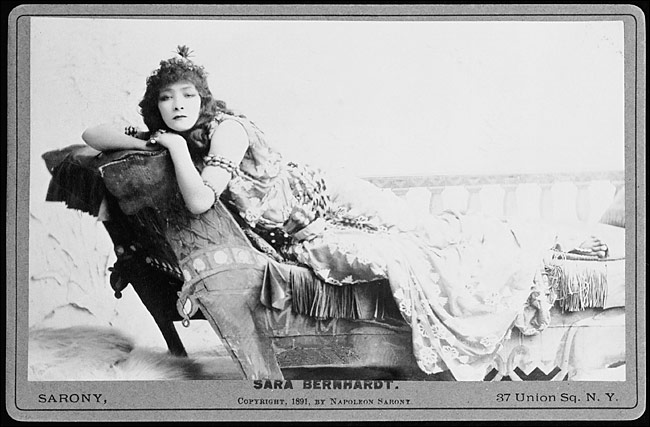
"The opening image in the fascinating exhibition that opens today at the Jewish Museum might at first seem to have very little to do with its main subject. The exhibition is devoted to the flamboyant 19th-century actress whose name was once invoked by mothers as a warning to melodramatic daughters, held up like a cross before Dracula: "Who do you think you are, Sarah Bernhardt?""
Sarah the Divine. In her own day she was known as the greatest French woman since Joan of Arc,the English Wonder of the World, about whom the novelist Edmond de Goncourt decalred in all seriousness, “” This woman has undoubtedly an innate amiability, a desire to please which is not put on, but natural….The life of madame Sarah Bernhardt may prove rthe greatest marvel of the nineteenth century”.One searches in vain for he modern counterpart , but Cornelius Otis Skinner in her biography, “Madame Sarah” likened Bernhardt to Napoleon Bonaparte,” Both had burning ambitions for personal glory which each attained. Both were bold adventurers yet careful organizers. Both had chronic ill health yet boundless, self-renewing energy. And both were supreme showmen.”
An enterprising photographer named Melandri to the picture above about 1875when Sarah, in her early thirties, was the reigning favorite of the Comedie Francaise. She had recently taken up sculpture and was working on a bust of her sister Regina when Melandri came to her studio on the Boulevard de Clichy. It was a large lit room fitted with exotic trappings: fur rugs, potted palms, scented satin pillows, that accompanied Sarah wherever she settled. In her white silk shirt and pants, white slippers and white tulle scarf; a costume that seemed totally unsuited to the messy work of clay modeling, Sarah gazes at us with a cool assurance and nonchalance. Melandri later sold prints of this photograph on the streets of Paris, and the fact that Sarah had allowed herself to be photographed in pants, or that she wore them at all, confirmed bourgeois opinion that she led a life of total abandon.
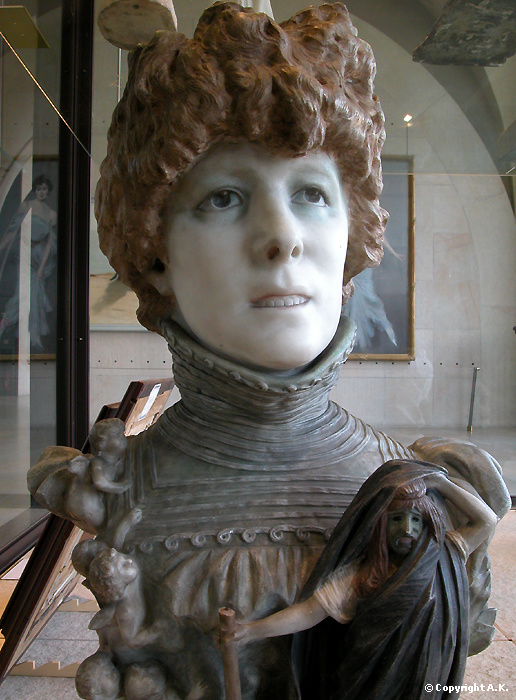
Jean-Léon Gérôme : Henriette Rosine Bernard (Sarah Bernhardt) : Sarah Bernhardt (1844-1923), comédienne, peintre et sculpteur - Blanche-Boldini-Helleu - Musée d'Orsay
Sarah’s career did not begin propitiously. Some twelve years before our photograph was taken, the Comedie francaise had signed her on as a probationary actress and given her the title tole in Racine’s “Iphigenie”. Almost overcome with stage fright, she gave a stiff performance and later the audience remembered chiefly her remarkable thinness. But characteristically, it was Sarah’s penchant for off-stage melodramatics , not her generally mediocre performances, that caused her dismissal: she broke a parasol over a stage doorkeeper’s head, slapped the face of a long established member of the company, and, to no one’s surprise except her own, was asked to resign from the Comedie Francaise.
After leaving another job with a smaller company, she threatened suicide but decoded instead to travel. In Brussels she fell in love with the young and handsome Prince de Ligne and, soon after returning to Paris, gave birth to their son Maurice. History had repeated itself, for Saeah was the illegitimate child of a beautiful demi-mondaine. Marriage with the prince was out of the question, but Sarah always referred to the affair as “THE” love of her life.
Determined again to succeed as an actress, she secured a place with the Odeon on the Left Bank. The second ranking national theatre oof France, the Odeon was more open to experiment than its more illustrious sister, the Comedie Francaise, across the Seine. She worked hard, and soon the critics began to notice the skinny actress with the beautiful voice, who, as one critic write, “charmed her audience like a little Orpheus”
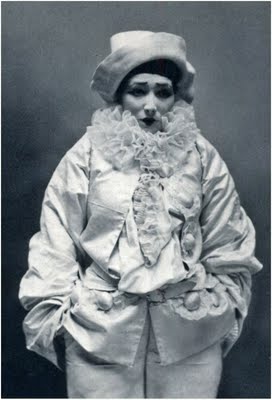
Sarah Bernhardt as Pierrot in Jean Richepin's pantomime Pierrot Assassin
Sarah spent six years at the Odeon, the adored God of Left Bank students and poets. Fashionable and distinguished followers also came to her dressing room or to her flat on the Rue de Rome to pay her court. Her unusual features, the eyes of a cat and the smile of a llama; and wraithlike body did not conform to nineteenth century standards of feminine perfection. Yet people described her as more than beautiful.The poet, Theodore de Banville stated, ” She is the Muse of Poetry herself. Neither intelligence nor artistry have anything to do with it. She is guided by a secret instinct. She recites as the nightingale sings, as the wind sighs, as water murmurs, as Lamartine once wrote.”
In 1870 the Seige of Paris brough theatrical life to a halt. Sarah, an almost hysterical patriot, started a hospital for the wounded in the foyer and lobbies of the Odeon. Though her own health was frail, she labored day and night for months as nurse, hospital administrator, and indefatigable fund raiser. For once, it was said, Sarah was not playing a role.
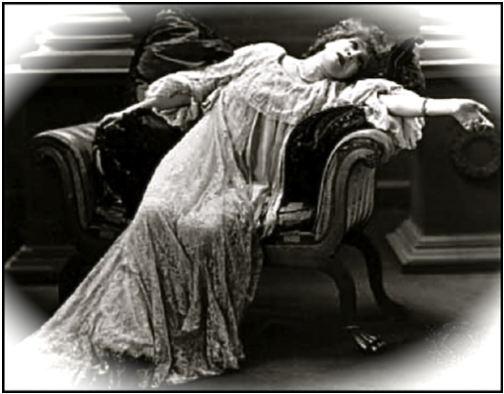
"Phèdre is to this day one of the most-produced and celebrated French-language theatrical works. The tragic construction, the deeply observed characters, and the richness of the verse have cemented Racine’s role as one of France’s most esteemed writers. Numerous great tragic actresses have taken on this challenging role, including most recently Helen Mirren in the National Theatre production and possibly most famously Sarah Bernhardt, whose Phèdre in 1906 was the first performance ..."
After the Odeon reopened its doors, Sarah gave her greatest performance yet, in January 1872, as the queen of Spain in Hugo’s “Ruy Blas”. Soon thereafter, the brightest new star on the Parisian stage rejoined the Comedie Francaise, and De Banville wrote, ” Her voive, like that of a lyre, holds the rhythm and music of poetry. …Make no mistake the engagement of Sarah Bernhardt at the Comedie Francaise is serious and violently revolutionary. It is poetry entering the house of dramatic art: it is the wolf in the fold.”
Though her fame was secure, she became obsessed by an urge to paint and sculpt. The actor’s art, she complained, was parasitic; she must create a work of art herself. She moved into the studio on the Boulevard de Clichy and engaged Matthieu Meusnier, a leading academic sculptor, to give her lessons. Before she had barely grasped the rudiments of modeling, she was tackling large scale projects. Her work enjoyed some success. The bust of Regina, on the stand in the photograph, was accepted for the Salon in 1875, and in 1876, she won an honorable mention for a grisly figure of an old woman holding the body of a drowned child. She continued to sculpt all her life; even after a leg amputation confined her to a wheelchair, when she was in her seventies, she modeled some figures of her family intended to be placed around her tomb which they never were.
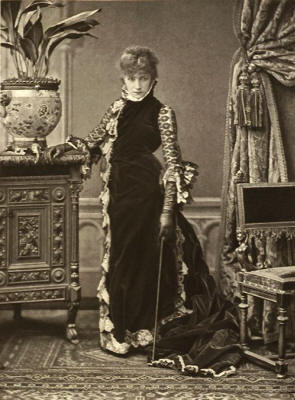
"In the early days of the silent film, most successful stage stars looked down their noses at the medium. A few "posed" for the cameras to commemorate a particular role, like a keepsake snapshot. But few thought of film as an art form. Not until Sarah Bernhardt's 1912 artistic and financial success Queen Elizabeth did her fellow stars begin to flock to the film studios in any great number. Most were one-shot wonders. But Madame Sarah made a total of eight films in the waning years of her life, and five were great hits. "
Most of the art critics found her work unworthy of mention, and perhaps it was to spite them that Sarah became a critic herself. She romped around the Salon galleries after rehearsals, dictating her opinions to a secretary who followed behind. The next day her column would appear in “Le Globe”, to circulate “among the avid readers, who must know what Sarah thinks of this or that picture”.
On Marilyn Monroe: “But what a feeble follower she was! As are the legions of other celebrities whose comet trails have streaked across the PR heavens in recent years. Of course, there are some similarities. We have come to expect from our celebrities sexual adventures and experimentation, painful vulnerabilities and intermittent illnesses, astonishing performances and unexpected talents, an ornate private life and plenty of indulgent egoism. All of which Bernhardt provided to excess.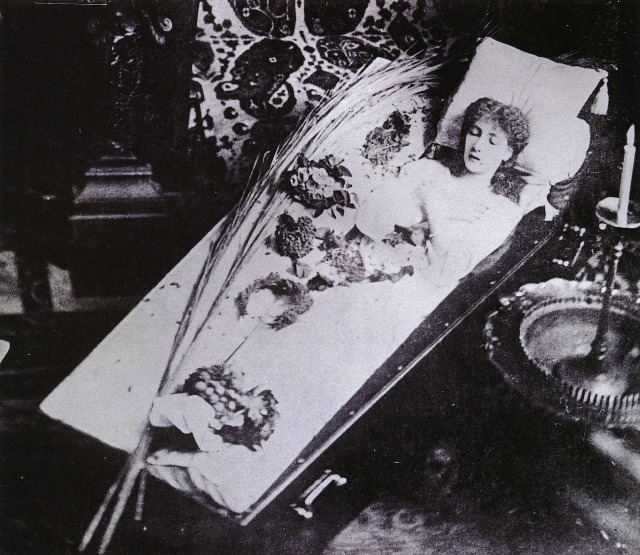
Born of a Jewish courtesan in Paris in 1844, then baptized and educated in a convent school, Bernhardt entered the theater and never looked back. Her lovers, Ms. Ockman points out, included Albert Edward, the Prince of Wales; Charles Haas, Proust’s model for Swann; Victor Hugo; Gustav Doré; and probably a variety of women as well. One may have been the artist Louisa Abbéma, who appears here as a marble bust sculptured by Bernhardt – the same bust that in a notorious photograph (circa 1880) stands watch over Bernhardt, who is draped with flowers, lying in a coffin. Bernhardt must have been captivated by death, both on stage and off. She wrongly believed she would die young (she lasted until 1923) and was entranced by skulls and bats, along with furs and wraps.”
Bernhardt was occasionally and disastrously blind to serious character deficiencies. The only man she ever married, Jacques Damala, was a womanizing scoundrel who drained Sarah’s bank account to support the morphine habit that eventually killed him. But the day Melandri took his photograph, that marriage lay some seven years in the future. That afternoon, however, as Melandri left the studio, Sarah would be looking forward to the daily gathering of her coterie. There were said to be three important times in the Parisian day: at oneo’clock, Leon Gambetta smokes his second cigar; at four o’clock prices fall in the Bourse; and at five o’clock, Sarah receives.

" She was entranced by skulls and bats. She loved wild animals and at one time had a pet lion and 6 chameleons. Early in her career, she purchased and began sleeping in a coffin to better understand her tragic roles. In fact, she preferred roles in which the character dies at the end. (When she played one such role before a boisterous American audience, she said, "If they don't keep quiet, I'll die in the second act.") She played both male and female parts, and was in fact openly bisexual. She acted without a prosthetic limb after her leg was amputated in 1915 (and refused an offer of $10,000 to exhibit the severed limb as a medical curiosity). "
Putting aside her sculptor’s tool and changing into a delicate tea gown, all white, for that was her favorite color, Sarah would arrange herself artfully against the satin pillows of her studio couch and await her guests.


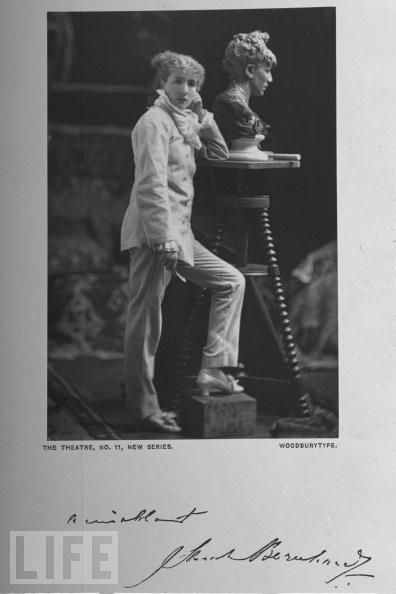

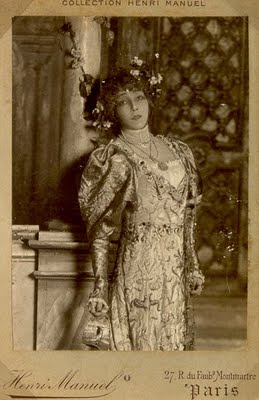



 COMMENTS
COMMENTS